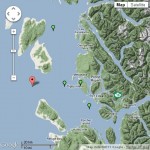new lighthouse for Cape Mudge…; Mar 3, 9… [Colonist, 1915-02-27, p. 10]
Mr H J Hillier, telegraph operator at Ucluelet, and Mr C C Binns, members of Ucluelet lifeboat crew, have earned a great reputation as fishermen among natives of West Coast Vancouver Island by reason of the skill displayed in landing a 60 lb salmon from a small boat in a choppy sea, according to information brought here by lighthouse tender Estevan. Although a larger fish is reported to have been caught at Ucluelet, the one handled by Hillier and Binns is declared to be the liveliest that was ever induced to grasp at the business end of a spoon bait.
It was only after the huge fish, which measured about 4′ 6″, had played itself out by its exertions, that it was hauled aboard through the combined efforts of the 2 men.
Large schools of salmon are now running on West Coast Vancouver Island.
Estevan was stormbound for 8 days. [Colonist, 1915-03-24]
Mariners are officially notified that the new concrete lighthouse, at Amphitrite Point, West Coast Vancouver Island, to replace the former lighthousewhich was washed away during a heavy gale last fall, has been put into operation. [Colonist, 1915-03-26]
Dispatched on an errand of mercy to Estevan Point, for the purpose of bringing to Victoria Mrs Jensen, Wife of lightkeeper at Estevan lighthouse, who is reported seriously ill. DLT Estevan, Captain Barnes, left port yesterday for West Coast Vancouver Island. A message was received yesterday at the local offices of the Marine Department stating that Mrs Jensen, who was recently operated upon in a Victoria hospital, has suffered a relapse, and as the case appeared urgent Estevan was ordered out at once. It is expected to be off Estevan early this morning, and in the event of the weather being calm the patient will be taken aboard and should arrive in port Mon am. Providing the weather is heavy there some difficulty will be experienced in making a landing and the arrival of the ship here may be delayed. Last night it was reported that a Southeast wind was causing a heavy swell off the point. [Colonist, 1915-04-04]
Sgt James V Carroll, 7th Battalion, Killed in Action, joined 88th Fusiliers Aug, 1914, aged 28, single. He had served 9 years in RMLI. native of England, left with 1st Canadian Contingent. Prior to coming to Canada he served 9 years as machine-gun Sgt with Royal Marine Light Infantry. Jun 8, 5 – reported Prisoner of War to Mr C Webb, Victoria. Sgt Carrol was formerly a cook on lighthouse tender Estevan and spent several years in Victoria. Aug 4, 5 – Prisoner of War. [Colonist, 1915-05-13, p. 1]
John Wright, San Francisco, died at Victoria, British Columbia, Aug 23, 1915, aged 84, native of Killearn, Scotland. He came to Victoria in 1859 to do architectural work along the Coast, being specially employed to design lighthouses. While in Victoria he was in charge of several important contracts, the most notable being the old Methodist church, Pandora/Broad Streets. While a local resident he became identified with 1st Presbyterian church. He left Victoria in 1866 for San Francisco, being accompanied by his partner, Mr F Saunders… [Colonist, 1915-08-25, p. 7]
50 years Ago files printed lately refers to an accident that had occurred on Xmas, whereby 5 lives were lost through the upsetting of a boat which was trying to make Race Rocks lighthouse. Mrs George Maynard, daughter of late John Davis, keeper of Race Rock lights, was an eyewitness of that tragedy, having been at the lighthouse at the time. Mrs Maynard clearly remembers having seen some of the occupants of the boat clinging to the bottom of the overturned craft for a long time. There was a lifeboat at the lighthouse, but it was a very unwieldy craft, requiring 18 men to handle it. [Colonist, 1916-01-01, p. 6]









